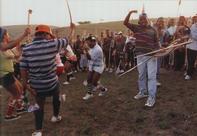
In the outlying rural areas of KwaZulu-Natal men are not allowed to take their sticks into the court houses of chiefs for fear that they might be used to settle disputes through violence.
Because the owners of umbrellas sometimes sharpen the metal ferrule at the top, effectively turning them into lethal weapons, these are also banned.

Historically, boys played with sticks while herding cattle. Over time this developed into a highly sophisticated fencing sport that is still practiced to this day. In most communities, this art of stick-fighting was passed on from one generation of boys to another, but since today boys are required to go to school, knowledge of this martial art has become increasingly sporadic.
Among groups like the Sotho, who still practice initiation, stick-fighting skills are perfected during the period of seclusion in the initiation lodge. In present-day KwaZulu-Natal, however, where initiation practices were abandoned in the late 18th-century, it is now sometimes taught at school.

During their initiation, Xhosa-, Sotho- and Ndebele-speaking youths learn fighting stick techniques and compete with one another to establish local champions who in some cases go on to compete with victors from other initiation lodges. In the past, skills like these were of vital importance to men entering the warrior stage of their lives.
Later, migrants also used sticks to defend themselves while travelling to and from the mines and cities where they went in search of work. But today the prowess initiates achieve by learning to fight with sticks is essentially symbolic.

In the second half of the 19th century migrant labourers all carried two or more sticks on their journeys between their rural homes and the diamond and gold mines that began to attract large numbers of men to Kimberley and Johannesburg.
Especially when returning to their families, they were vulnerable to attack by bandits seeking to strip them of their wages. Men moving in and out of newly-established urban centres also carried sticks because, as one observer noted, they were a 'natural means of defence'.